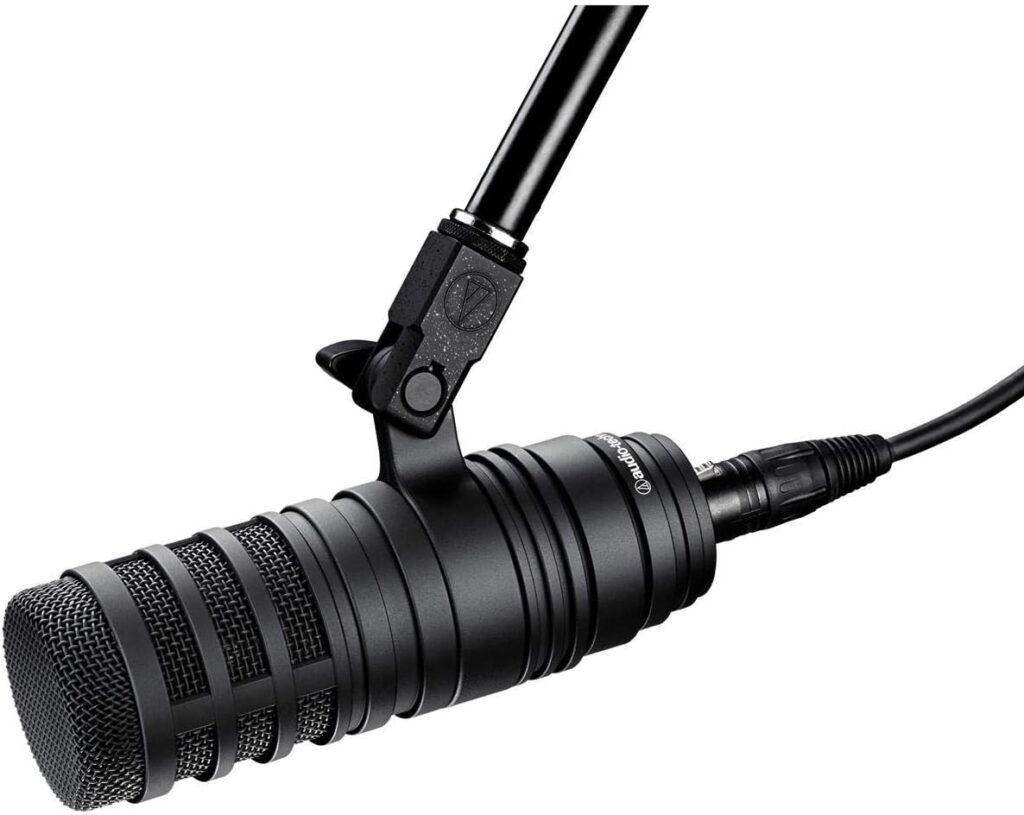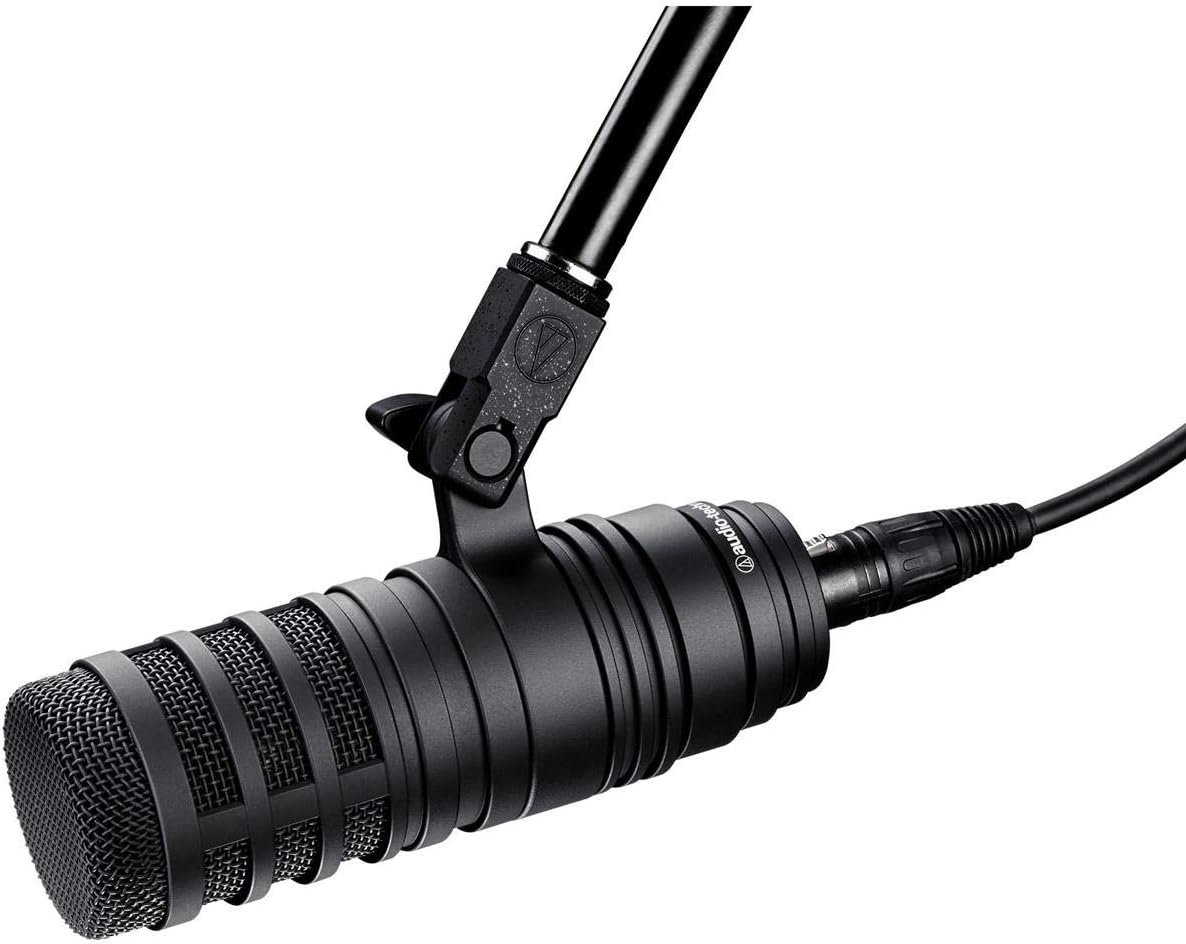Audio Technica ATR BP40 Review
The ATR BP40 makes a striking first impression with its substantial build quality and distinctive appearance. Weighing approximately 632 grams (1.4 lbs), the microphone conveys a sense of durability and professional-grade construction immediately upon handling. Its all-metal chassis features a classic broadcast microphone form factor with a side-address design that feels reassuringly solid.
The black finish with subtle metallic accents gives the BP40 a classic, understated aesthetic that would look at home in any professional broadcast setup. Audio-Technica has clearly designed this microphone with both function and form in mind, striking a balance between professional appearance and practical usability.
Technical Specifications

Before diving deeper into performance, let’s examine the key technical specifications of the ATR BP40:
- Type: Dynamic
- Polar Pattern: Cardioid
- Frequency Response: 50Hz to 16kHz
- Output Impedance: 450 ohms
- Sensitivity: -48 dB (3.9 mV) re 1V at 1 Pa
- Weight: 632g (1.4 lbs)
- Dimensions: 164.0 mm (6.46″) long, 56.0 mm (2.20″) diameter
- Output Connector: 3-pin XLRM
The microphone also features a switchable 100 Hz high-pass filter that can be engaged to reduce unwanted low-frequency rumble or proximity effect when needed.
Design and Build Quality
The ATR BP40’s design reflects Audio-Technica’s decades of experience in creating professional audio equipment. The microphone features a large-diaphragm dynamic capsule housed in a robust metal chassis. Its heft isn’t just for show—the substantial build quality helps dampen vibrations and provides excellent isolation for the sensitive components inside.
One of the BP40’s most notable design features is its patented floating-edge construction for the diaphragm. This innovative approach helps optimize diaphragm movement and contributes to the microphone’s impressive low-frequency response—unusual for a dynamic microphone in this class.
The integrated humbucking coil is another thoughtful design element, helping to resist electromagnetic interference that can plague studios with multiple electronic devices. This feature is particularly valuable in modern broadcast environments where computers, monitors, and other equipment can generate significant electromagnetic noise.
The included AT8483 mounting clamp provides secure attachment to microphone stands, though many users may want to invest in a shock mount for additional isolation from mechanical vibrations. Audio-Technica offers the AT8484 shock mount as an optional accessory, which complements the BP40 perfectly.
Sound Quality
The sonic signature of the ATR BP40 is where this microphone truly shines. It delivers a warm, rich broadcast-quality sound that has become increasingly desirable in radio, podcasting, voiceover work, and even music production.
The BP40’s frequency response of 50Hz to 16kHz is well-suited for vocal applications. The microphone exhibits a slight presence boost in the upper midrange (around 2-5kHz) that adds clarity and articulation to voices without becoming harsh or sibilant. This characteristic makes voices sound naturally enhanced and helps them cut through in a mix.
The low-frequency response deserves special mention—the BP40’s large diaphragm and floating-edge design allow it to capture rich bass tones that many dynamic microphones miss. Male voices particularly benefit from this extended low end, gaining authority and depth without becoming muddy or boomy.
When the high-pass filter is engaged, the BP40 effectively reduces proximity effect (the bass boost that occurs when speaking close to the microphone), allowing for more consistent tonality regardless of microphone technique.
The BP40 employs a cardioid polar pattern that effectively rejects sound from the rear while maintaining good sensitivity to sources in front of the microphone. This directional quality helps isolate the primary sound source and minimize room reflections or background noise—a crucial feature for broadcast applications.
The off-axis rejection is consistently good across the frequency spectrum, avoiding the colored off-axis sound that plagues some directional microphones. This characteristic makes the BP40 forgiving in less-than-ideal acoustic environments.
Despite being a dynamic microphone, the BP40 exhibits surprisingly good transient response, capturing the nuances and articulation of speech with accuracy. While it may not match the transient detail of a good condenser microphone, it offers a compelling balance between the warmth associated with dynamic mics and the detail typically expected from condensers.
Performance
The ATR BP40 excels in its primary intended application: broadcast and podcast vocals. The microphone’s rich tonality and presence boost create that coveted “radio voice” effect that makes announcers sound authoritative and engaging. The effective off-axis rejection helps minimize room noise and isolate the speaker’s voice, making it ideal for home studio setups that may not have ideal acoustic treatment.
The high-pass filter proves especially useful in broadcast settings, allowing hosts to work close to the microphone for improved isolation while preventing the proximity effect from making voices sound unnaturally boomy. This feature, combined with the BP40’s natural resistance to plosives (due to its multi-stage windscreen), makes for cleaner, more professional-sounding vocal recordings.
Voice actors and narrators will appreciate the BP40’s ability to add body and presence to voices without requiring extensive post-processing. The microphone imparts a subtle flattering quality that enhances voices without coloring them unnaturally.
For commercial voiceover work where a commanding, rich tone is desired, the BP40 delivers excellent results. The microphone’s ability to handle both intimate quiet passages and louder exclamations without distortion makes it versatile for dramatic voice performances.
While primarily designed for broadcast applications, the ATR BP40 has found favor among music producers and engineers for specific applications. Its robust low-end response and smooth midrange make it an excellent choice for recording kick drums, where it captures the impact and depth without becoming muddy.
The BP40 also performs admirably on guitar cabinets, particularly for rock and blues styles where its midrange character helps guitars cut through dense mixes. Some engineers have also had success using the BP40 for recording brass instruments and even as an alternative vocal microphone for singers who typically overload condenser microphones.
ATR BP40 vs Competitors
The ATR BP40 occupies an interesting position in the market, offering features and sound quality that compete with more expensive broadcast microphones while remaining more affordable than many premium options.
The Shure SM7B is perhaps the most natural comparison point, as it has long been the industry standard for broadcast dynamic microphones. The BP40 offers a slightly more extended low-frequency response and arguably requires less gain than the notoriously gain-hungry SM7B. However, the SM7B provides more extensive on-board filtering options and has the advantage of decades of proven reliability in professional settings.
In terms of sound, the BP40 tends to have a more immediately impressive, rich quality, while the SM7B has a more neutral character that some engineers prefer for its versatility. Price-wise, the BP40 typically retails for less than the SM7B, making it an attractive alternative.
Another classic broadcast microphone, the Electrovoice RE20, offers different advantages. The RE20’s Variable-D technology virtually eliminates proximity effect, providing consistent tonality regardless of microphone position. The BP40’s switchable high-pass filter approaches this functionality but doesn’t quite match the RE20’s position-independent performance.
The BP40 tends to have a more modern, present sound compared to the RE20’s flatter, more neutral character. For traditionalists, the RE20 remains a gold standard, but the BP40 offers a compelling alternative with its own sonic signature at a lower price point.
Final Thoughts
The Audio-Technica ATR BP40 represents an impressive achievement in microphone design, offering professional broadcast quality at a price point accessible to serious enthusiasts and working professionals alike. Its combination of rich sound, robust build quality, and thoughtful features makes it a standout option for anyone recording voice in a broadcast, podcast, or voiceover context.
For those entering the world of professional audio or looking to upgrade from entry-level equipment, the BP40 offers a compelling balance of performance and value. Its ability to produce that coveted “broadcast voice” sound without extensive processing will appeal to content creators looking to elevate their production quality.
While it may not dethrone the established classics like the SM7B or RE20 in major broadcast facilities, the ATR BP40 carves out its own well-deserved place in the pantheon of quality broadcast microphones. For many users, it may well represent the perfect balance of professional performance and reasonable cost—a true sweet spot in the competitive microphone market.
